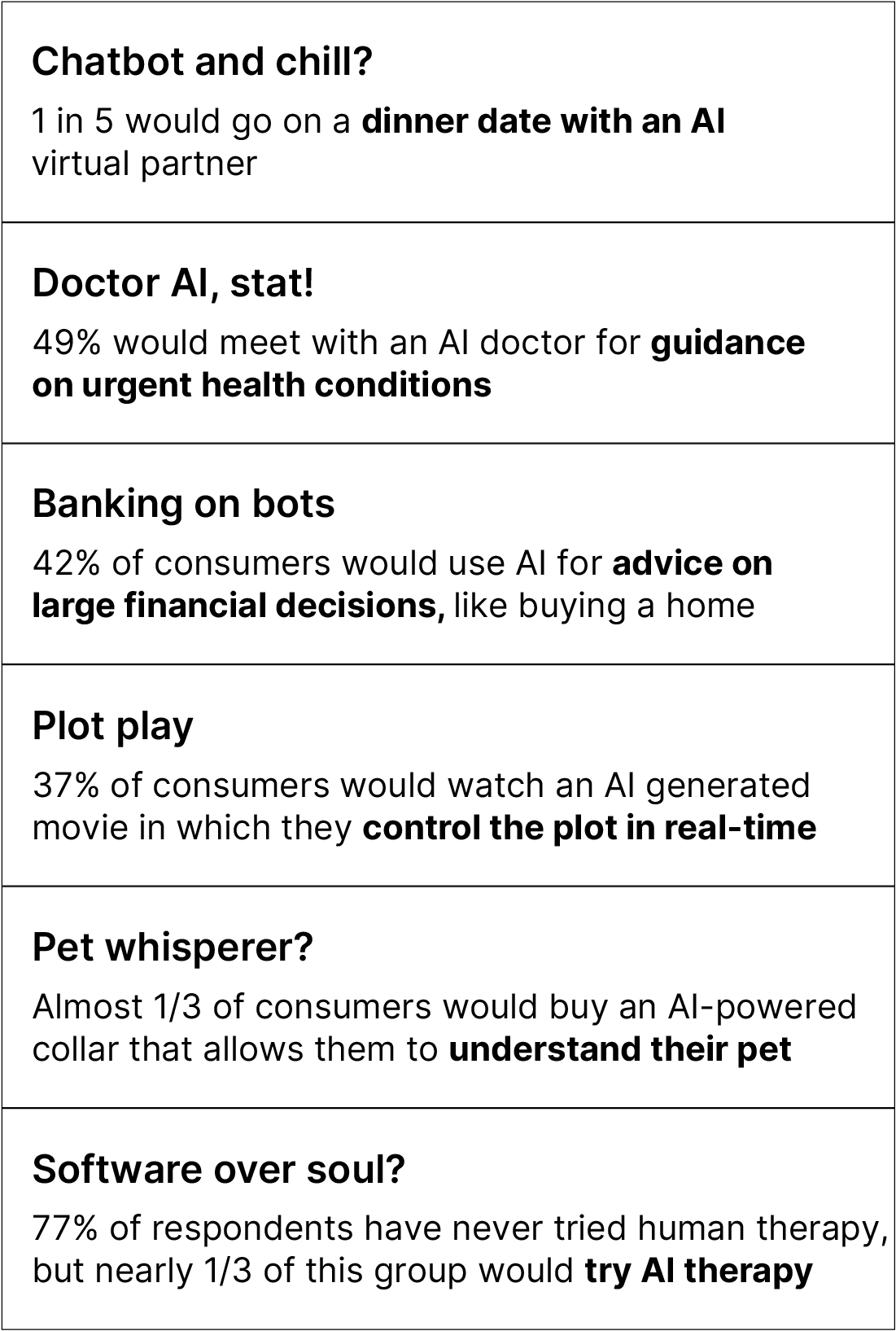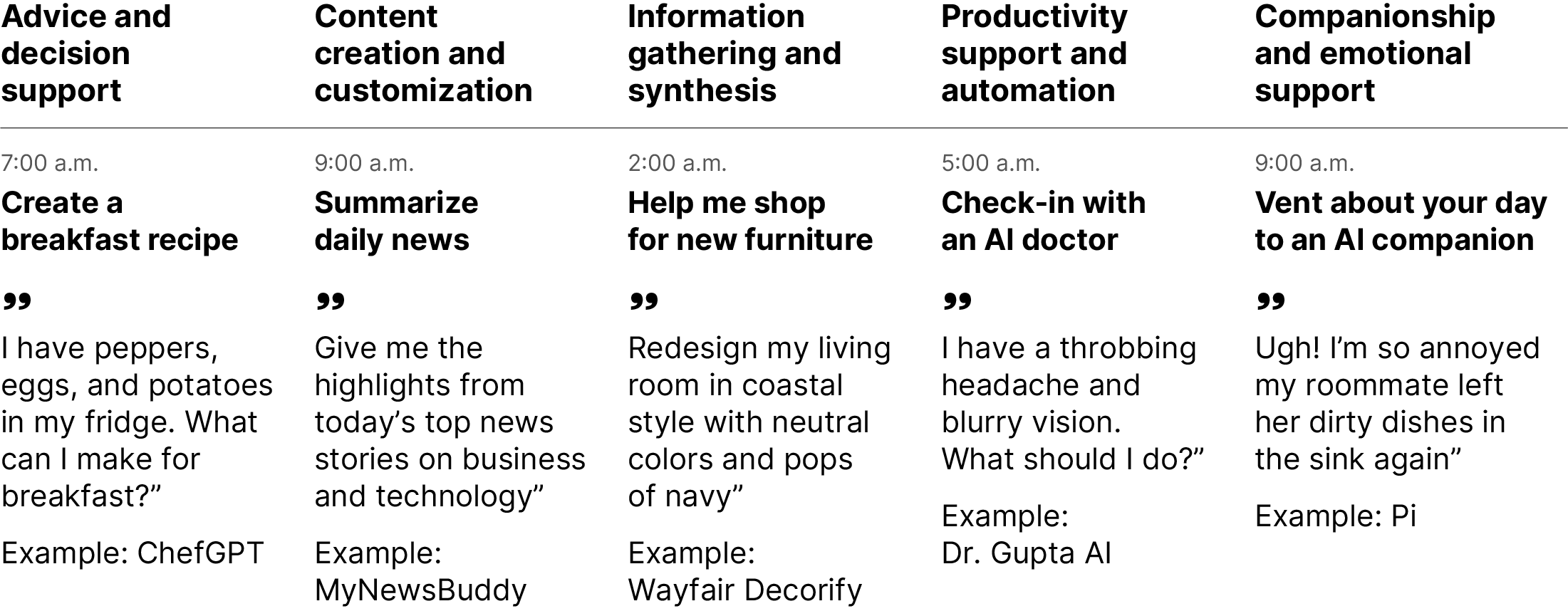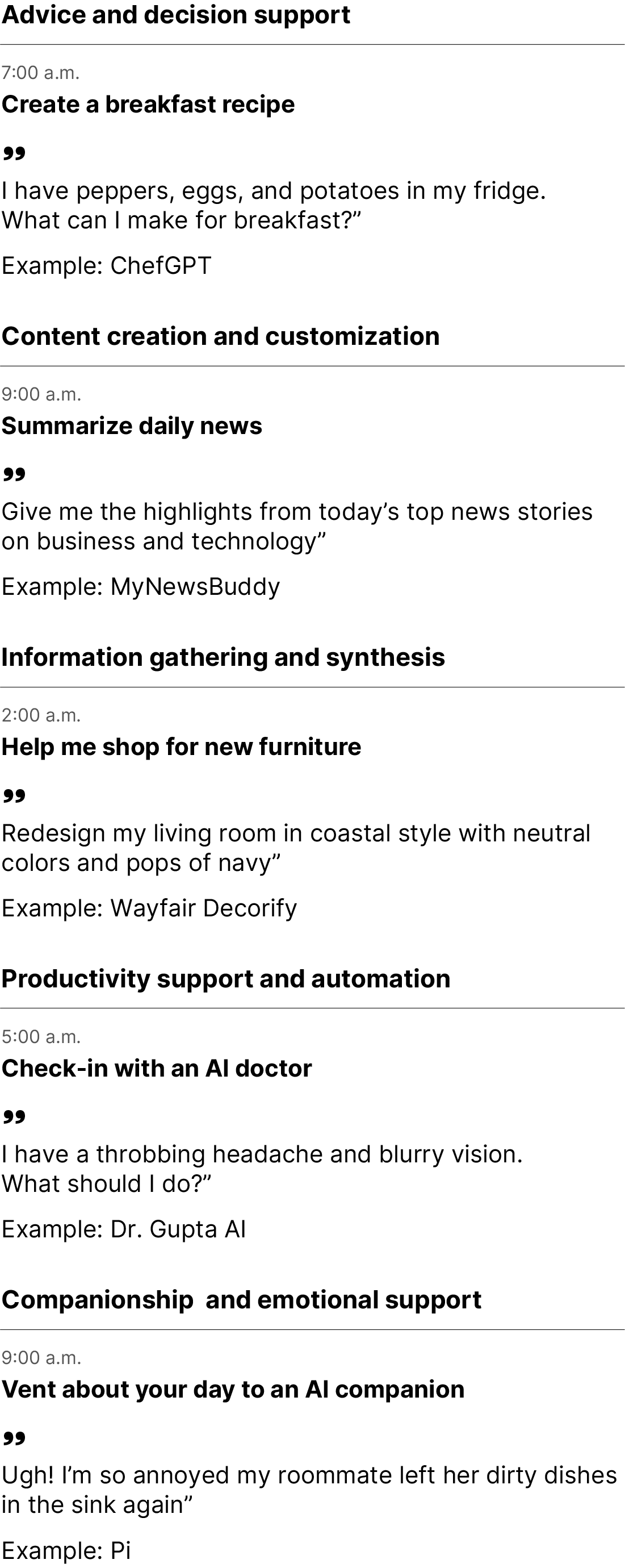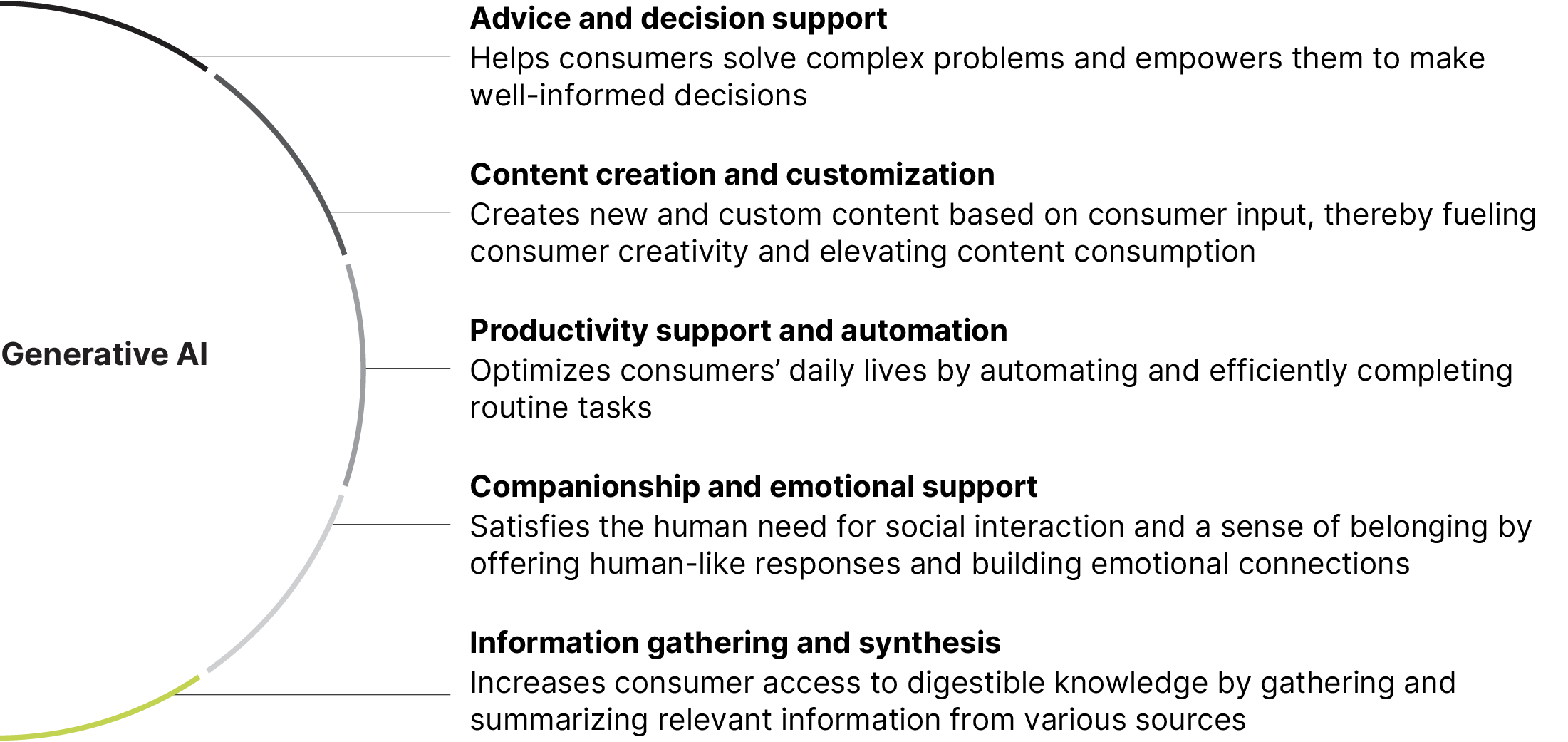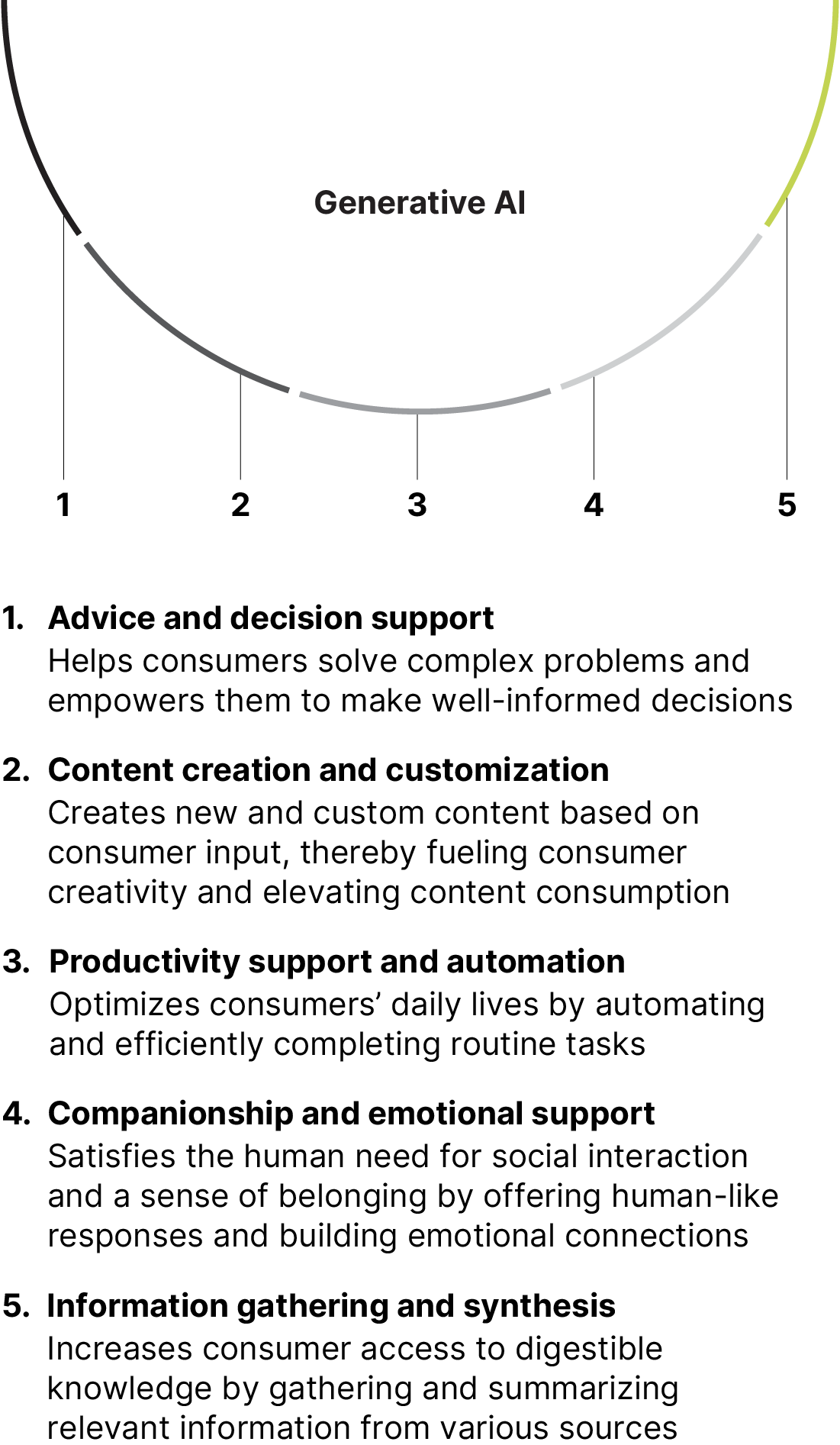The emerging AI-powered universe
Generative AI is poised for omnipresence in our everyday lives. It will fundamentally reshape a broad universe of products and services, opening up greater access to some that have historically been subject to scarce resources, pricing, or geographic barriers and allowing entirely new ones to flourish.
This is true across many sectors, but we see several industries as especially ripe for positive disruption. For retail, generative AI takes personalization to new heights. In healthcare, generative AI has the potential to expand access to on-demand health support and reduce doctors’ administrative burden. Generative AI could likewise raise the bar in the media industry, ushering in a new age of immersive and interactive experiences. In education, engaging new tools that are tailored to each student's needs will elevate the learning experience.
Consumers are already envisioning ways to interact with generative AI that either replace or go beyond the experiences typically associated with analogous traditional services. For instance, consumers currently turn to generative AI as a trusted source of financial advice on matters ranging from budgeting to big decisions like purchasing a home. When asked if they would prefer humans or generative AI for help with financial advice and planning, over one-third of respondents say they prefer generative AI. And when asked why they use generative AI versions of financial advice and banking customer service, our survey respondents report seeking to fulfill needs not typically associated with those areas of financial services, such as novelty, fun, and even connection.
While there is still much to be learned about this phenomenon, one possible interpretation is that consumers feel less anxious and more curious and engaged when they are able to participate in dialogue without feeling “put on the spot” in front of another human, whom they might worry will judge them. If borne out, this dynamic could be a boon to sectors like financial planning and preventative healthcare, where getting consumers over their reluctance to engage has historically been a significant entry barrier. This is just one example of how generative AI will not only help businesses offer consumers better/faster/cheaper versions of the same things they do today, but will also uncover new needs to be solved and open up new vistas for connection with end-customers.
While companies across a broad swath of industries already have begun to skillfully leverage generative AI technologies to revamp traditional offerings, it is only the beginning. Companies will soon introduce entirely different offerings created by the combination of new technological capabilities and the new human desires those capabilities unlock. As always, early adopters may have a competitive advantage.
Key takeaways for business leaders
The experiences of innovative organizations that are pioneering new, generative AI-driven solutions identify four key imperatives for others:
Expand and explore to scale the business. By enhancing existing capabilities like product design generation or branding and marketing, generative AI can strengthen a company’s command of existing markets and facilitate expansion into new ones.
Reclaim resources to maximize efficiency and prioritize customer connection. From outsourcing simple customer service interactions to optimizing inventory, generative AI can be used to streamline business processes, freeing up time to focus on lasting connections with customers.
Hyper-personalize offerings to keep customers happy. Consumers are demanding personalized products and offerings more than ever before. Generative AI can help businesses achieve an intimate understanding of each individual and deliver ultra-personalized offerings tailored specifically to them.
Embrace generative AI’s surprising ability to excel in “human” areas – and challenge your organization to be more human in turn. Many consumers see generative AI as fulfilling emotional needs, but they also indicate areas in which human interaction still dominates. By recognizing these complementary strengths, businesses can more effectively leverage a combination of human and technological resources to meet consumer needs.
Excitement / Existentialism
Igniting a consumer revolution: Generative AI democratizes access and unlocks novel experiences
The early days of a generative AI-powered future
Less than a year after the introduction of ChatGPT, 50% of CEOs said they are integrating generative AI into their products and services, according to IBM. That’s a lot of consumer offerings — across many different areas — that will soon have a generative AI component. And there’s already robust demand.
Not only is adoption rapid, but consumers are also indicating a willingness to interact with generative AI even in the most “human first” of products, services, and interactions — challenging assumptions about what skills are uniquely human and how generative AI can serve humankind. Our research finds that in a future world in which AI works well, one in five respondents would consider going on a virtual date with a generative AI partner. And in some cases, the appeal of generative AI surpasses that of humans: Of the 77% of consumers who have never tried therapy with a human, nearly one third say they would try generative AI therapy in the future.
These emerging products and services are likely to be different from the versions of products that consumers interact with today. Travel planning, for example, is no longer just about figuring out how to get from point A to B; it is becoming a choose-your-own-adventure experience powered by generative AI recommendations on destinations, activities, and even potential travel companions to meet along the way. Likewise, healthcare will focus on prevention and personalized care, in part through generative AI tracking, diagnostics, and treatment plans.
Consumers are also thinking about the responsibilities that will be required to make them successful. There is a global consensus that businesses need to inform their customers of generative AI use. Consumers who have lived through the rise of big tech and the resulting concerns over privacy and data are eager to know what they are using — as well as how any inputs they provide are in turn being used.
Generative AI as the great equalizer
Generative AI may be the great equalizer in many industries with traditionally high barriers to access or adoption. For one thing, it is poised to give people virtual access to experiences from any corner of the globe, eliminating many geographic barriers that reinforce unequal access to services. Generative AI is also poised to supercharge humans to serve more consumers, more efficiently.
Healthcare is an example of an industry in which both of these processes are helping to level the playing field. Our survey found that 46% of respondents have tried using generative AI to help diagnose minor conditions based on symptoms they shared with these tools, and 73% say it somewhat or fully meets their everyday healthcare needs. Even in countries with relatively accessible healthcare systems, such as Canada and the United Kingdom, 36% of respondents reported using generative AI for medical purposes. Our qualitative interviews suggest that one of the reasons consumers are so willing to use generative AI healthcare is that it provides access to advice when a human doctor is inconvenient to reach. When humans do interact with doctors they sometimes find (or will soon find) that those doctors are aided by technology that allows them to see patients more efficiently. Perhaps it is for these reasons that we see some of the strongest interest in paying for an AI doctor appointment in countries where there is a relatively low ratio of doctors to the overall population.
The growth of AI within healthcare also provides an example of how generative AI may influence the ways humans adapt their skills and training to the changing technological landscape. As the availability, speed, and accuracy of generative AI-provided medical advice improves, many human doctors could be forced to innovate to keep up. Those in markets with an adequate supply of healthcare professionals could see fiercer competition with generative AI, requiring them to focus more on the value of their human touch. In addition, concerns about data privacy and the potential for AI-generated misinformation must be addressed to ensure responsible adoption of generative AI across industries.
Imagine two potential patients with flu-like symptoms, one in Paris and one in Mumbai. They are both relatively open to consulting with a generative AI doctor about their condition (46% versus 68%). But the patient in Mumbai — where human doctors are in shorter supply — is also willing to pay nearly 3.5 times more than the patient in Paris for a consultation with a generative AI doctor, with prices adjusted for purchasing power parity. This disparity shows a strong opportunity for AI-driven business model innovation, particularly in supply-constrained markets. It also highlights potential differences in quality of care; in markets with less access to human doctors, generative AI could become a welcome alternative to rushed care from overwhelmed physicians. Nations with a more adequate supply of doctors may have more resources to push doctors toward more "human-centric" care, allowing doctors to focus on their unique value proposition.
That said, the most likely outcome of generative AI’s expansion in these industries is a partnership: humans and generative AI working together to provide adequate, precise, and accessible services to an eager population of global adopters in healthcare and beyond. And although equalization will not be the only story of generative AI, it is one of significant promise, meaningful change, and potential ready to be harnessed.
Necessity, the mother of invention
The driving force of innovation is often need, and achieving generative AI’s potential promise will depend on its maturation and widespread adoption in various specific contexts and use cases. While notably high across the board, consumer appetite varies across both geography and sector. For instance, across the surveyed countries, retail consistently inspires the most interest from among the consumer sectors where we have country-level comparisons available.
The rapid integration of generative AI into myriad products and services is not just a testament to its technological prowess, but also to its potential to democratize access and enhance human experiences across the globe. As we stand on a generative AI revolution, it is imperative that businesses, regulators, and consumers move forward with a shared vision of ethical use, transparency, and collaboration. Consumers' willingness to embrace generative AI, even in areas traditionally dominated by human expertise, signals a shift in societal norms and expectations.
However, the true measure of success for generative AI will be its ability to augment human capabilities, bridge access gaps, and provide equitable and quality services, while navigating the complex landscape of data privacy and misinformation. The future beckons with a promise of innovation driven by necessity. As societies explore the vast possibilities, it is clear that the synergy between human ingenuity and artificial intelligence will redefine the boundaries of what is possible, ushering in an era of extraordinary opportunity.
Elevate / Erode
A generative AI-powered tomorrow: How will this technology elevate and reinvent everyday consumer experiences?
Illustrating generative AI's wide-ranging capabilities across industries
As we’ve seen, generative AI is sparking transformation across industries, from healthcare to retail and education. This transformation is not solely about the technological capabilities of generative AI but also how these capabilities are presented to users. Understanding the distinction between the backend capability of generative AI and its user interface will unlock meaningfully different areas of value.
A key aspect of generative AI’s effectiveness is its reliability, which is significantly enhanced by retrieval augmented generation, or RAG. Consider a hypothetical “RecipeGPT” concept, a generative AI application meant to share recipes in the culinary field. Without RAG, if RecipeGPT were to rely solely on a large language model (LLM) for generating recipes, the results might be mixed. For instance, while 50% could be good, a significant portion could turn out impractical or even inedible. This inconsistency arises from the LLM's reliance on generating content based on patterns in data it was trained on, without verifying the accuracy or practicality of the information. However, if RecipeGPT were equipped with RAG, it would first access a pre-verified database of tried-and-true recipes. This step ensures the generative AI suggestions are not only creative but also grounded in culinary reliability and practicality. The integration of RAG thus transforms RecipeGPT from a novel tool with variable output to a dependable assistant for culinary creativity and exploration.
The significant advancement for consumers with generative AI lies in the evolution of its interface, particularly the conversational layer. This development transforms interactions with generative AI, making them as intuitive as speaking with a human. The interface acts as a seamless link between the user and generative AI's sophisticated capabilities, enabling natural, effective, and human-like interactions. The true value of generative AI is in this intuitive interaction, not just in its functions but in how effortlessly users can engage with it.
Beyond the interface, generative AI offers meaningful backend capabilities too that can enhance the consumer experience. In customer support functions, generative AI enhances service quality, leading to increased customer satisfaction. Its ability to analyze customer interactions allows for proactive improvements, constantly evolving and adapting to each organization and the consumers they serve. This feature transforms feedback and complaints into actionable insights, enabling continual enhancement of products and services.
The wide-ranging benefits of generative AI across various industries are clear. Note, however, that generative AI is not creating the same transformed experience everywhere. There are five distinct functional areas where AI can improve the products and services in an industry: advice and decision support, information gathering and synthesis, content creation and customization, productivity support and automation, and companionship and emotional support.
Retail: generative AI as advice and decision support
In retail, a key trend is the shift toward hyper-personalized customer experiences. Retailers are now able to tailor product offerings and marketing strategies to individual consumer preferences, thanks to generative AI. While the examples we cover here come from the world of retailing, it is easy to envision analogous applications in finance, insurance, telecommunications, and beyond – all areas where customized customer communication can dramatically improve customer engagement and business outcomes.
New generative AI capabilities provide online shoppers with the opportunity to preview items in hyper-realistic settings before making a purchase. Over one-third of our survey respondents say they would use generative AI to try on clothes virtually, with female respondents expressing the greatest interest at 39%. Consider Google's "virtual try-on tool," which allows consumers to visualize products on different body types, sizes, and skin tones using generative AI. It not only elevates the shopping experience by providing a more inclusive and realistic view of products but also grants retailers insights into a diverse range of customer preferences. The tool shows how industries can use generative AI to cater to a broader audience, improving both the customer experience and business intelligence. The applications could be especially prominent in sectors like real estate, hospitality, and automobiles, where visual representation plays a significant role in the consumer decision-making process.
In grocery and other fast-moving retail segments, personalization is also reaching new heights, with generative AI powering, for example, bespoke flyers for customers. Some 52% of our survey respondents express interest in receiving a generative AI-produced marketing pamphlet that informs them of the best deals of the week based on their past purchases. This is more pronounced in older generations; non-Gen Z respondents are 13% more likely to express interest compared with Gen Zers. This personalized approach has been shown to double click-through rates and increase sales by 2% to 5%.
The retail sector's innovative use of generative AI offers a glimpse into a future in which personalized customer experiences become the norm across all industries. The lessons learned here illustrate how deeply understanding customer preferences and tailoring both products and communications accordingly — including down to the level of individual customization — provides businesses with a material advantage. As in these examples, generative AI can help executives across sectors envision and implement strategies that transform customer engagement and operational efficiency in their respective fields, ensuring their organizations remain competitive and relevant in an increasingly generative AI-driven world.
Media: generative AI as content creation and customization
Generative AI is revolutionizing the media landscape, transcending conventional content consumption and creation and enabling a new level of interactive and immersive experiences. Lessons from the world of media are also applicable to sectors like education and marketing, where engaging and interactive content is increasingly vital for audience engagement and retention.
Media has come a long way since the monoculture era of the 1980s, when big box office films dominated. Platforms like Netflix have pioneered a segmented approach to content, curating films and shows for highly specific tastes. Now, with generative AI, media is moving even further into the realm of hyper-personalization. Our survey found that nearly one-third of respondents would be interested in sharing their ideas with generative AI to create original movies or TV shows. Gen Zers (31%) and millennials (30%) were more inclined to use generative AI for this purpose than Gen Xers (25%) or boomers (23%). Interest is particularly high in India, where nearly half of respondents would use generative AI to bring ideas to life.
Similarly, our survey indicates that more than one-third of respondents are interested in AI-generated music that mirrors the style of their favorite artists. This trend is more pronounced among Gen Zers, who are 56% more likely than boomers to show enthusiasm for AI-assisted musical experiences.
YouTube’s Dream Track feature is an example of this trend. Users can input a concept, like “a ballad about love,” and choose artists such as Charlie Puth to collaborate with generative AI in creating unique music. This suggests an emerging paradigm in which consumer expectations center on personalized and interactive experiences across many sectors. In educational technology, for instance, such personalized content may be used to enhance learning experiences, making them more engaging and tailored to individual learning styles. And in the world of advertising, infinite bespoke versions of a pitch could be tailored to uniquely appeal to each recipient.
Digital twins — virtual representations of real-world entities in video form — such as those created by Metaphysic, represent a significant leap in how generative AI can recreate and reimagine human characteristics and performances. These digital twins, trained on an actor’s past performances, capture nuances like voice and gestures. This technology has vast implications, extending into sectors like virtual customer service, where digital twins could provide highly personalized and interactive experiences.
There are potential downsides of hyper-personalization that should not be overlooked. In the context of social media, envision a future in which every short video is uniquely tailored to an individual, potentially isolating people further and reducing shared cultural experiences. This highlights the need for a balanced approach to personalization, considering its impact on societal cohesion and shared cultural values.
Taken together, these advancements in media show how generative AI’s potential extends well beyond text generation and processing, opening an array of possibilities for immersive multimedia experiences across industries and product segments. At the same time, the ethical and legal dimensions highlighted by voice cloning and digital twins underscore the need for careful consideration in deploying AI technologies, especially in industries such as law and financial services, where regulatory compliance and ethical considerations are paramount.
Healthcare: generative AI as advice and decision support and information gathering and synthesis
Generative AI's emerging role in healthcare offers key lessons for other industries on expanding accessibility, enhancing service delivery, and improving operational efficiency.
At least half of the world’s population lacks access to essential healthcare services. Alain Labrique, Director of the Department of Digital Health and Innovation at the World Health Organization, recognizes the role of generative AI in bridging this gap. He told the Oliver Wyman Forum that “Emerging LLM technology can make trustworthy health information more accessible through chatbots, virtual humans, and other technologies." This approach democratizes health information access and includes necessary human oversight for safety and equity. The empathetic aspect of AI interfaces, while vital in healthcare, also has implications for education and other sectors as well as functions such as customer service.
The World Health Organization's digital healthcare worker tool, Florence 2.0, shows how generative AI can be effective in healthcare. The tool provides support for stress management, healthy eating, and physical activity through empathetic and interactive communication — making healthcare guidance more accessible and engaging.
DeepScribe’s AI-driven documentation tool is another example of generative AI's impact. The company reports being able to reduce the time doctors spend on administrative tasks by up to 75%, allowing for more patient-focused consultations and care. This efficiency not only enhances patient experiences but also improves the overall quality of care, underscoring the broader benefits generative AI can deliver in fields where administrative duties are prevalent.
To see the impact of enhanced service delivery, imagine a hypothetical John, in a generative AI-enhanced healthcare setting. Before even deciding to visit the doctor, John engages with a friendly generative AI system from the comfort of his home. This AI provides not just cursory guidance but also detailed home care advice, potentially averting an unnecessary doctor's visit by equipping John with the right information to manage his condition. Should a visit be necessary, the AI assists with pre-visit procedures, replacing tedious paperwork with a streamlined, high-quality chatbot interaction that prepares John for his appointment.
Upon arrival at the clinic, John's doctor receives a synthesized briefing of his past medical history and current concerns, all collated and presented by the AI in a digestible format. This ensures that when the doctor enters the room, they are fully informed and can dedicate the entire consultation to engaging with John, focusing on his needs without the distraction of sifting through records. This interaction exemplifies the dual benefits of generative AI: It offers an initial "empathetic" touchpoint that extends beyond intake efficiency to proactive care guidance, while enabling healthcare professionals to deliver more patient-centric care. This model, where technology and human expertise collaborate, reflects the transformative potential of generative AI across various professional domains.
Education: generative AI as (personalized) information gathering and synthesis
In education, our survey respondents are optimistic about generative AI’s potential: 32% selected education as one of the areas that would benefit the most from generative AI in the next 30 years. The technology is redefining learning tools, making them more engaging and responsive to individual needs, for example via AI-enhanced textbooks and language learning platforms.
Khanmigo, an application developed by Khan Academy, utilizes GPT-4 technology to simulate the experience of having a personal tutor to provide individualized coaching, with additional explanation and encouragement where a student needs it. Unlike traditional educational tools, Khanmigo engages students in a dialogue, prompting them to explain their reasoning and identify areas where their understanding might be lacking. This interactive approach fosters deeper learning and critical thinking. In each session, Khanmigo adapts to the student’s responses, offering tailored challenges and questions that push cognitive boundaries.
Another example, Duolingo Max demonstrates how generative AI can teach students through the generation of human-like interactions. The technology leverages AI to simulate real-world conversations, allowing users to practice conversational skills with various characters in realistic scenarios. After each conversation, the app provides AI-generated feedback, helping users refine their language skills and prepare for future interactions.
While the advances in the education sector is making with generative AI are instructive for other sectors, so too are the concerns about the misuse of generative AI, such as cheating and plagiarism. These risks highlight the importance of developing applications that enhance, rather than undermine, the consumer experience. In sectors like e-commerce, this translates to creating systems that assist consumers in making informed decisions without misleading or manipulating users.
Adaptation / Obsolescence
Beyond code: What we can learn from generative AI’s surprisingly “human” essence
Exploring AI’s ‘human’ essence
Generative AI is forcing a reconsideration of long-held assumptions about what it means to be uniquely human. This manifests itself both in the way humans respond to generative AI and in the skills it demonstrates.
Even though 59% of respondents report treating generative AI like a human by using polite language such as “please” and “thank you,” 53% still say generative AI content lacks “soul” – that uniquely human essence.
Nonetheless, one-third of our survey respondents said they believe generative AI can surpass human creativity, and nearly one-third said they believe it can capture the depth of human emotion, challenging how much of a monopoly we really have on our supposedly uniquely human traits and abilities.
Generative AI’s surprising ability to meet humans’ emotional needs
In the prior section, we introduced five functional areas across which generative AI typically provides benefit to businesses in the way they serve customers. What may be less expected is that generative AI seems to have a surprising ability to also meet many of humans’ more emotional needs. That is, generative AI’s benefits may ultimately lie not only in productivity gains, but also in an enhanced ability to build relationships, inspire curiosity, and alleviate anxieties.
When we asked survey respondents who have recently used generative AI, across a variety of specific use cases, what fundamental needs it met for them, the responses were surprisingly diverse and balanced across the spectrum of human needs. While “efficiency” (arguably the most functional of the needs studied) came in first place, respondents also reported being motivated in their generative AI usage by a desire for learning, novelty, connection, and even the search for meaning.
Nowhere is generative AI’s surprising emotional deftness on better display than in the world of personal relationships.
Consumers are head over heels for generative AI
With loneliness on the rise globally, people are turning to a new, virtual friend and collaborator. Our survey respondents are over five times more likely to say generative AI meets their need for safety when building social connections, compared with human counterparts. They are twice as likely to say generative AI meets their need for creation and self-expression, compared with humans.
Some consumers are even “getting serious” with generative AI: Our survey findings show that one in five respondents would be interested in going on a virtual dinner date with a generative AI partner, transcending the boundaries between the digital and physical worlds. Some 13% of respondents would even be interested in taking things to the next level with generative AI by forging a romantic connection. Male respondents are 27% more likely than females to report interest in developing a romantic bond with generative AI. Gen Z respondents are 25% more likely than other generations to report being intrigued by the idea of generative AI romantic bonds. Respondents from India are the most open to exploring romantic connections with AI: 38% of respondents there say they would go on a virtual dinner date with AI, followed by 30% in Hong Kong, and 29% in the UAE.
People are turning to generative AI partners for myriad reasons: mending a broken heart, gaining confidence to get back in the game, supplementing existing relationships where needs aren’t fully met, and just plain old companionship. With generative AI, consumers may see a way to achieve these goals in a safer environment (whether or not this turns out to be accurate), with a lower risk of rejection and a greater ability to customize a companion to individual preferences.
There are obvious and unresolved concerns about generative AI partners. First and foremost, although they may serve as an impermanent fix, they could also contribute to the loneliness epidemic in the long run if consumers find them so engaging that they turn away from opportunities for genuine human connection. Here generative AI’s duality is visible once again, leaving society with both solutions and questions.
Beyond love, generative AI also has the potential to transform family ties and human connection. Imagine, for example, being able to talk to a departed loved one indefinitely. With new technologies, companies are enabling consumers to create a lasting legacy, through personal avatars that can interact with their family long after they have passed.
Can AI teach us to be more human?
Generative AI’s unexpected knack for simulating – and maybe improving upon – the human touch has plenty of real world, commercial applications, beyond the realm of personal relationships. In healthcare, this is evident in the surprising emotional capabilities of generative AI during patient interactions. In medical school, students are trained to provide bedside care, using empathy, open body language, and eye contact to soothe patients and ensure concerns are addressed. This comes easier to some doctors than others — and for some, it requires practice and focus to master all the necessary behaviors and best practices. It seems impossible to consider that a generative AI-powered doctor could ever replicate a skill many human doctors struggle to perfect themselves.
Yet a recent University of California San Diego study shows that generative AI may be able to do just that. When it comes to providing high-quality medical information with compassion and understanding, they found ChatGPT outperforms human doctors by a significant margin.
The study examined responses to 200 patient medical questions provided by ChatGPT and human physicians. A panel of healthcare professionals concluded that ChatGPT’s answers surpassed those of human doctors in nearly 80% of cases, with greater empathy being the primary distinguishing factor. In many instances, the doctors’ responses were brief and hurried, compared with ChatGPT’s in-depth and personable replies.
The caliber of care generative AI can provide to patients is a powerful example of its long-term potential. Not only do generative AI systems have an infinite data set of knowledge to access for each patient inquiry, but they also can replicate thoughtful, empathetic care. This raises the question: Can generative AI teach humans how to be more human?
Applicability in personal finance, and beyond
Only one-third of adults worldwide are financially literate, according to the 2015 S&P Global Financial Literacy Survey. For most, this hinders their ability to make financially sound decisions. Even those who can access professional guidance to inform their decisions suffer from anxiety about working with a financial adviser, fearing judgment, confusion, and the inability to know whom to trust.
Now generative AI is emerging as a trusted adviser, easing fears and helping consumers to feel empowered in the process. Some 42% of survey respondents said they would place their faith in generative AI to guide them in making major financial decisions like buying a home, paying for college, or saving for retirement. When asked if they would prefer humans or generative AI for help with financial advice and planning, 36% of respondents report they prefer generative AI.
In the United States, the middle class leads this trend. Our survey found that 32% of such respondents said are interested in using generative AI for advice on significant financial decisions, more than high-income (28%) and low-income (25%) Americans. Gen Zers and millennials lead the shift toward AI; our survey shows this demographic is 36% more likely to report that they would use AI for significant financial decisions, compared with Gen X and boomers.
Why are so many consumers willing to use generative AI for financial advice? Surprisingly, the answer may be the emotional needs that generative AI can provide. Our survey reveals that generative AI financial advisers are 23% more likely to provide a sense of connection compared with human ones and are nearly four times likelier to provide a sense of meaning than their human counterparts. Overall, respondents are 43% more likely to say generative AI meets their needs for learning when receiving financial advice, compared with humans. Generative AI is already making customer service experiences more efficient; it is the number one reason consumers turn to the technology when seeking assistance. Meanwhile, efficiency is only the fifth most common reason consumers call human customer service agents, trailing connection and peace of mind. While customer service interactions are rarely described as “fun,” generative AI could change that: 12% of respondents said interacting with a generative AI customer service agent fits that description.
Of course, there are legitimate concerns about how sound the financial advice from generative AI may be, and consumer uptake should not get ahead of risk management. Sturdy guardrails are necessary to preserve consumer trust and reduce risk as new products and services emerge.
Human identity, reimagined
So, what do we know from observing how humans have integrated generative AI into their lives? By many accounts, person-to-person loyalty is at an all-time low: Our survey finds that 30% of respondents say they would not spend extra for a “human touch” if generative AI offered the same quality. Even in the stickiest of consumer and brand relationships, generative AI is prompting a reassessment of what consumers value, and a reshuffling of allegiances. This is indicative of a deeper transformation: It is not merely a change in consumer behavior but a sign of a broader reevaluation of what we, as a society, hold dear. The implications are profound. Loyalty, once rooted in the personal bonds between individuals and brands, is being redefined in the face of technological convenience and reliability.
This shift toward a preference for AI-generated interactions comes with its own set of challenges and limitations. While generative AI has made leaps and bounds in mimicking human sentience, these systems still lack the depth and continuity of human consciousness. Each interaction with generative AI is an isolated event, devoid of the rich context of human experiences and emotions that characterize human existence. This can lead to misunderstandings and a sense of disconnect for those who are not well-versed in the nuances of generative AI capabilities — potentially resulting in friction when engaging with products and services that employ these technologies.
To navigate this new reality, both consumers and businesses must cultivate a deeper understanding of the limitations inherent in generative AI. It is essential to recognize that while these tools can augment and enhance our capabilities, they currently can’t deliver the richness of genuine human interaction. Thus, we must redefine what it means to be human in a world where our roles, relationships, and responsibilities are being transformed by the machines we create. This involves a conscious effort to reaffirm the values that are uniquely human — creativity, empathy, and ethical judgment — and to ensure these values are interwoven into the fabric of our future society.
Ultimately, an age dominated by artificial intelligence requires a reimagining of human identity. Society must embrace the strengths of generative AI while simultaneously fostering and celebrating those qualities that are inherently human. By doing so, humans can create a symbiotic relationship with technology in which humanity and AI coexist, complement, and enhance one another, ensuring a future rich in the aspects of life that make people human.



